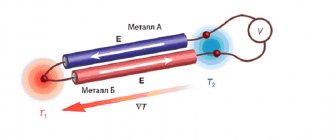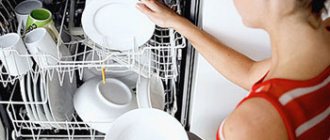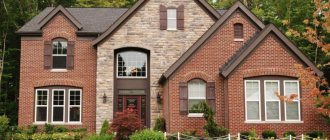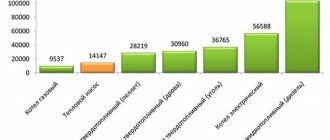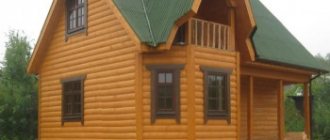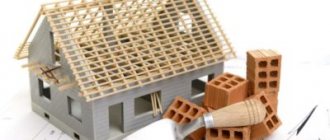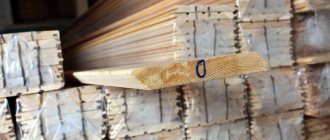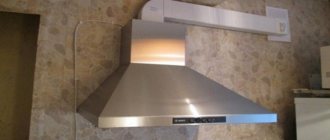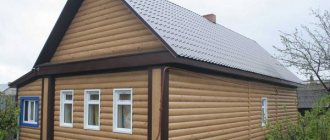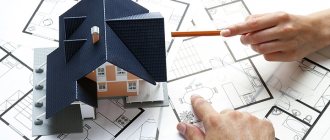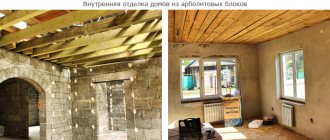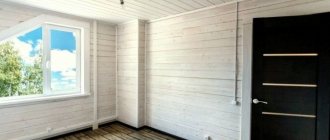Why do you need façade finishing?
When a house is built, it can look decent without any painting, plaster or other façade material. It may seem that there is no need to carry out work on the appearance of the building, but most often this is not the case.
Any exterior decoration additionally performs the following functions:
- Protection of walls from natural external influences . If you don’t dive into technical calculations, then in simple words the problem is formulated as follows: materials that can be used to create load-bearing walls are susceptible to the influence of natural external influences and vice versa. For example, brick, most often used for construction, absorbs moisture, which can first lead to the appearance of efflorescence, and over time to a change in the physical characteristics of the material. Protecting your walls with exterior cladding is very important to increase the lifespan of your entire home.
Protection of wooden walls from atmospheric moisture Source otdelka-orsk.ru
- Heat and sound insulation of the interior of the house . Materials suitable for the construction of load-bearing walls do not always have optimal heat and sound permeability. Previously, this problem was solved by building thicker walls, but a significant waste of materials is not economically feasible. For example, the thermal conductivity of ten centimeters of mineral wool and a brick wall about two meters thick is the same. Therefore, most exterior cladding technologies include the installation of special materials that can increase insulation performance with a small layer thickness. In addition, the use of such systems will create a comfortable atmosphere indoors, which will not depend on the weather outside.
A layer of heat and sound insulation is laid under the exterior finishing Source scity.com.ua
- Fire safety at home . Most modern building materials belong to the flammability category NG or G1, which means that they do not support combustion at all or melt without releasing substances harmful to the human respiratory system. At the same time, the construction of wooden houses, which belong to the category of increased fire danger, is widespread. Finishing the external walls of a wooden house with modern facade materials significantly reduces the risk of external fire. Even if there is a fire inside the house, fire-resistant finishing will prevent the fire from spreading to neighboring areas.
Much attention is paid to the fire safety of materials Source ebtim.com
- House facade decoration.
See also: Catalog of companies that specialize in facade and finishing materials.
Features for retaining walls
Such wall structures are installed on a local area with an uneven landscape in order to level the soil level, or to create areas with horizontal zoning.
In order to compensate for the varied pressure of inclined areas of soil on the walls, two types of structures are used :
- massive with significant design weight, so that lateral forces tending to move the structure are not able to do this;
- thin-walled structures - the wall is equipped with elements that contribute to the creation of forces in the ground directed in the opposite direction to overturning.
The adoption of a design decision will depend on the actual budget of the structure, the available time for the work and the functional purpose of the retaining walls. The first option is characterized by an increased specific consumption of concrete and embedded reinforcement, the second increases the volume of excavation work.
Technology for constructing retaining walls for terracing the adjacent area :
- mark the boundaries of the wall;
- cords are pulled according to the design;
- make a trench along the width of the sole;
- make an underlying layer below 40 cm of the heaving soil level from two layers of crushed stone and sand;
- compact the crushed stone-sand base and cover it with a waterproof layer of roofing felt;
- install formwork with a height of 30 cm above the soil level;
- the foundation is poured with M150 concrete;
- a retaining wall is erected, most often from concrete blocks.
Full details on retaining wall construction can be found here.
Requirements for facade finishing of houses
Everyone chooses different methods of facade finishing and at the same time pursues their own goals. But in any case, there are objective requirements that materials for exterior decoration of the walls of a house must meet:
- low overall thermal conductivity coefficient;
- preventing the formation and accumulation of condensation in the finishing layer;
- maximum vapor permeability;
- moisture resistance;
- resistance to physical impact (hail or accidental impacts);
- resistance to UV rays;
- do not deteriorate or change their characteristics when exposed to chemicals (sometimes contained in sediments depending on the location of the house, can be cleaned with detergents);
- possibility of operation at subzero temperatures (depending on climatic conditions);
- durability;
- resistance to wind load;
- Fire safety;
- do not attract various kinds of parasites and rodents that settle in the walls of houses;
- simplicity and minimal installation time;
- maximum range of decorations;
- attractive appearance.
The beauty of the exterior decoration is one of the main factors of choice Source dizainvfoto.ru
All materials for exterior decoration of the house must meet the specified requirements.
Therefore, in order to make the best choice, you need to carefully study the product labeling, since the range of characteristics is quite large.
Soundproofing
For “ringing” walls, which include wood and porous concrete blocks with a thickness of up to 200 mm, along with thermal protection, the installation of sound insulation and absorption systems will be required.
They can also be installed both externally and internally. External noise protection from street noise is the most effective and can absorb up to 60 dB of noise. It is combined with thermal insulation, purchasing a special acoustic insulation, for example, mineral wool.
The internal wall noise protection system is the most expensive and will be effective when the house carries out comprehensive sound protection of all structural elements adjacent to the walls: floors, ceilings, windows and doors.
There is a frame noise protection system for thick and bulky insulators in the form of mats and a frameless one for thin panels mounted directly on the wall plane with dowels and screws.
Read more about soundproofing here.
What is the exterior decoration of a house?
Types of exterior decoration of a country house can be divided into two main groups:
- wet finishing of the building;
- dry lining.
Wet finishing involves the process of applying water-soluble mixtures to the wall. Polymer compositions that are insoluble in water, but are in a liquid state before use, can also be applied. The technology for working using this method is quite simple, but in any case, experience in handling materials is required - for example, sometimes it is necessary to wait a certain time from preparing the solution to its application, from the start of work to putting the coating into operation.
In turn, dry methods of exterior finishing involve attaching ready-made building materials to the wall using special devices and dowels. The process technology is somewhat more complicated, but it takes relatively little time to create the entire system.
Wet and dry facades Source chrome-effect.ru
It is clear that completely different building materials are used for each method. Therefore, some performance characteristics are quite different.
How to build it with your own hands?
Before the construction of walls begins, preparatory work is carried out. This complex includes the preparation of machines and mechanisms, equipping the construction site with fire-fighting equipment, tools, wall and auxiliary materials. Scaffolding is installed and the construction site is fenced off.
Before erecting wall structures, basic preparatory measures are carried out :
- Check the horizontal level of the foundation under the wall.
- The geolocation of the axes and the location of the walls of the house is carried out according to the project.
- When laying bricks, the walls are divided into sections, and these, in turn, are divided into plots according to the number of workers, and in height - into tiers of 120 cm.
- The first tier is performed directly from the flooring, and the subsequent ones from special scaffolding.
- Transfer the main axes of the walls to cast-offs and secure them in the board with 2 nails.
- Intermediate axes are obtained by straight-line measurements.
- To obtain fixed axes, wire is pulled over nails.
- Using a plumb line and stretched wire, the wall axes are placed on the base and marked with paint in the form of lines.
- A leveling moisture-repellent solution of cement and sand up to 2 cm is carefully applied to the base.
- Perform cut-off waterproofing of the foundation to prevent capillary suction of water.
- 2 layers of rolled roofing material are laid on the solution with an overlap of 150 mm, leaving the outer edge along the edge of the future wall.
- A thick layer of mortar is applied, which will become the starting level for the future wall.
Video description
For a clear overview of façade finishing using the dry method, watch the video:
Such finishing materials include:
- block house (made of wood or plastic; externally imitates wooden logs; insulates the house well; withstands wind loads, but has low strength and a high price);
- wooden lining (outwardly it can imitate any lumber; it is characterized by high strength, wear resistance, long service life; it has a high cost);
- siding (made of durable plastic; has a relatively low cost; has a long service life, ease of installation; is not resistant to strong impacts; has various forms, including a block house, ship timber, vertical siding and even the form of laminated veneer lumber).
Dismantling
Load-bearing walls serve as capital walls, and therefore independent dismantling of such a wall, without making changes to the project and coordinating it with regulatory organizations, is not possible.
Certified specialists to perform such operations and are responsible for the safety of the work and the facility are involved in carrying out such important work. Otherwise, unprofessional dismantling may lead to the collapse of the house and human casualties.
On your own, you can dismantle non-load-bearing partitions in the order that was used during assembly. As a rule, when building a partition, a gap is left in front of the ceiling, filled with plaster and tow.
When dismantling the partitions, it is cleared, the trim and baseboards are removed, and then the wall up to 12 cm thick is demolished :
concrete ones are removed using diamond cutting;- plasterboard - remove the sheathing and then the frame;
- partitions - the sheathing is removed and then the frame is broken;
- glass blocks are first removed from the external components, and then the frame is destroyed;
- stone partitions are dismantled using the impact method using a classic sledgehammer, hammer, chisel and hammer drill;
- wooden ones are removed by sawing, starting with dismantling from the struts and beams.
What and when is the best time to choose?
When purchasing building materials, it is not always possible to study the offered product thoroughly. Therefore, you need to know what factors you need to pay attention to first.
Before purchasing, you need to know in what climatic conditions the material will be used. If there are significant temperature changes and large amounts of precipitation, it is necessary to choose the most frost-resistant and water-resistant materials. They can be facing bricks, porcelain stoneware, natural or artificial stone, silicate, silicone paints, and some sandwich panels. If the façade is exposed to a large wind load, it makes sense to use siding or a block house.
If there is a possibility that the façade will be subject to physical stress, such as impacts, you should pay attention to the most durable finishing options. These are durable cement mixtures, polymer plasters, porcelain stoneware or stone slabs.
How to determine whether a wall is load-bearing or not, design features
If you are interested in solving the issue, the selection of functional walls will take place without hassle. The easiest way to start is by studying the structural plan of a building. The document is obtained by visiting representatives of the capital construction department. Registration of technical passports for all buildings is mandatory. Finding suitable components is easy if you have the skills to read technical documentation on load-bearing, self-supporting and non-load-bearing walls.
The location and thickness will tell you what the purpose of the structure is. Only old decorative materials from the surface of the walls must be removed first. The walls differ from each other in characteristics. They try to pass on the plan to the masters.
- The use of bricks assumes that the 28-centimeter thickness makes the wall load-bearing. The number of laying bricks and the thickness increase simultaneously.
- With panels as a base, the load-bearing wall is any wall from 14 cm or thicker. This causes difficulties with redevelopment.
- Thicker than 20 cm is a load-bearing wall located inside the monolith.
Studying the construction plans from the developer seems to be the simplest solution. The frameless fastening method is also fixed there.
Registration of technical passports for all buildings is mandatory.
What actions can be performed with load-bearing walls?
The construction industry places strict demands on load-bearing walls. It is important for owners to remember this to avoid problems with regulatory authorities. A preliminary study of the documentation helps.
The prohibitions are as follows:
- Grooving for wiring or laying pipes;
- Transfer to other places;
- Demolition. The action leads to a decrease in the stability of the building, even if the base is aerated concrete.
But there are also things that are completely acceptable to do.
- Expanding and creating doorways.
- Use a drill for holes where the diameter is small. The use of self-supporting type of walls is also allowed for such work.
But even working with openings will require mandatory interaction with the administration. Damage to the wiring is very likely, so the question of its presence will be known in advance.
Even working with openings will require mandatory interaction with the administration.
Siding
Sidings are cladding of building walls that perform two functions: utilitarian (protecting buildings from external influences such as rain, wind, snow, sun), and aesthetic (decorating the facade of buildings).
of siding , and we will now briefly describe their properties:
8.1 Aluminum siding
– perfect for offices, residential premises in multi-storey buildings. Due to the softness of the panels, the use of this material allows you to update walls and ceilings in a short time without significant costs or complex repairs.
8.2 Wood siding or laminated lining
– contains wood fibers, compressed at high temperatures with a special resin. Externally, the texture imitates natural wood. This siding is very expensive and is flammable.
Decorative plaster
For many, plaster is a repair material designed to level walls. Today there is another type used as finishing. True, you still rarely see it in apartments: a massive transition from wallpaper to other materials has not yet been observed; and decorative plaster is not cheap. Although this main drawback is compensated by the advantages in application and result. Here are some of them:
- Many types of plasters are easy to apply. Therefore, it is not always necessary to invite specialists;
- due to the applied layer, a certain level of thermal and noise insulation is achieved, which cannot be achieved either with wallpaper or, especially, with paints;
- great decorative possibilities: using plaster you can imitate sand, stone, wood, marble and much more;
- the plaster coating has good strength, which wallpaper, of course, cannot boast of;
- Replacement of the coating is carried out quite rarely. Some types can last for many decades.
The negative side of decorative plaster lies not only in the price, but also in the repair of walls. It is quite troublesome to clean the surface of the finish, and even to level it with new material.
Types of decorative plaster according to preparation method
Decorative plasters are sold in two types (from the ready position). The first ones are ready for application; They are packaged in buckets, which is also convenient. The second are dry mixtures that need to be prepared. Many buyers are faced with the question of which plaster to choose.
The good thing about ready-made mixtures is that they can be applied after opening the bucket. There is no need to rush here; it is also not necessary to use up all the material, since the product has an expiration date.
But from dry compounds the mixture must be prepared by mixing with water. This needs to be done correctly. So, you need to prepare the amount of material that will be used. The water must be heated to the required temperature, otherwise the mixture can be spoiled. You need to add the powder to the water (and not vice versa), while stirring - for example, with a construction mixer.
In addition, you need to follow a number of cooking rules: the water must be clean; without any precipitation or anything else; you need to mix until the lumps are completely destroyed; After this, you need to leave the mixture for a few minutes, closing the lid and then stir again. Yes, and you need to apply the finished plaster quickly, because after a while it hardens and becomes unusable.
And, most importantly, you need to carefully read the instructions, since everything is important here - from the proportions of powder and water to the “viability” of the prepared composition.
It would seem that the finished mixture is better in all respects. But that's not true. For starters, it costs more. In addition, its shelf life is not as long as that of dry formulations before they are prepared. Therefore, if it is possible to properly prepare and apply such plaster, there is an opportunity to save money.
Differences in composition
According to this criterion, decorative plasters are divided into:
- mineral. The cheapest option. It is produced in dry form, so you will have to prepare it before application (as described above). If you are not satisfied with the white color, you will have to resort to painting after finishing. The advantages include vapor permeability and the ability to wash with water. But the service life of such finishing is relatively short (about 10 years), and fear of mechanical damage can reduce this figure;
- acrylic. With the help of acrylic resin added to the composition, manufacturers achieve plasticity of the material, high adhesion and water-repellent properties. Alas, plaster is flammable; therefore, for example, you should not decorate the wall with it near fireplaces. The material is easy to apply, but when purchasing, you need to pay attention to the date: if the deadline is coming to an end, it is better not to take a bucket, because it will be difficult to work with the composition;
- silicone. The best option, apart from the price. Elastic, vapor-permeable, durable, and also easy to clean. Thus, facades are cleaned simply by passing rain. Another nuance is the need for a special primer, also silicone. But, if you have the means, the result is worth it;
- silicate. This plaster also has a number of advantages: strength, water-repellency, ease of maintenance, etc. But due to the release of harmful substances, it is rarely used indoors. It is also not easy to apply: due to the rapid setting, a certain skill is required.
Classification by filler type
A long list can be provided here. But for this it is easier to highlight a separate review; in addition, many of the types (for example, flock or mosaic) are not so common. Therefore, we will limit ourselves to the most popular options. They include such plasters as:
- structural. It contains grains, thanks to which quite beautiful effects are achieved. The most popular are “fur coat”, “lamb” and “bark beetle”;
- textured. These compositions have various additives, such as wood fibers or pebbles. Textured plasters allow you to imitate the surface of wood, stone, velvet, etc. Often used in various offices, but they also look great in apartments;
- Venetian Very expensive, but quite original mixture. It was invented more than two thousand years ago by mixing marble remains (such as dust) with water. The main component has not changed today. Venetian plastered walls look as if they were lined with real marble. In addition, if the room is well lit, you can observe the effect of an internal glow. To the price of plaster, you need to add the cost of the services of a master, and not just anyone, but one who has experience working with Venetian plaster, since others cannot decorate walls with it.
Wall panels
A very good solution in many matters. Thus, many types of panels (for example, wood or metal) have good strength. In addition, they are installed in two ways: with glue (liquid nails) or with a frame.
The first method is similar to wallpapering a wall; in this case, the surface should be smooth and not suffer from moisture.
But the option with a frame is more practical. The fact is that in this way you can hide various wires and pipes under the finish. In addition, insulation can be laid in the space between the panels and the wall. Therefore, the heat and sound insulation achieved cannot be compared with the performance achieved by wallpaper, paint and plasters.
The panels also have another side. So, many types are quite expensive. If frame fastening is provided, you must either have the necessary skills (for example, in assembling sheathing) or contact specialists. In addition, the frame takes up a certain space, which negatively affects oversized rooms.
Regular or 3D
In addition to flat panels, three-dimensional, that is, convex, ones can be purchased on the construction market. Their advantage lies in the originality and uniqueness of the design they create. You can easily verify this - you just have to look on the Internet for pictures of panels with convex patterns.
But this finish also has a downside. So, 3D panels steal even more space than regular ones. Therefore, such finishing is justified only in large rooms. In addition, dust accumulates on the forms, which requires more frequent cleaning. It is also believed that such patterns can be overtiring; To avoid this, it is recommended to finish only part of the room.
Material for production
Wall panels are made from many materials.
- glass. Well suited for bathrooms and kitchens. They are distinguished by fire resistance, durability and beautiful appearance. The finishing glass is tempered, which prevents pieces of broken finishing from injuring anyone. But decorating walls with glass is so expensive that often a small part of the room is finished with these panels - for example, the area near the stove in the kitchen;
- wooden. These panels are good for decorating living rooms and bedrooms. The aesthetic appearance created by wooden elements is impressive. Caring for them is also easy: manufacturers treat the panels with wax or varnish so that they are not afraid of water. But even such finishing will not be cheap: expensive types of wood are used for production (for example, ash, walnut, maple). In addition, it must be washed carefully: the use of abrasive sponges and many detergents is prohibited. True, the price problem can still be solved: in addition to wood, there are panels made of fiberboard, chipboard and MDF, which are cheaper. This also previously included lining, but it has become so popular that it is considered as a separate type of finishing;
- plastic. An excellent option for those who do not have large funds. They are also very easy to wash, because plastic is not afraid of either water or many substances. The big disadvantage of such panels is their fragility: a small impact can cause a crack. Therefore, it is important to buy spare parts. By the way, this applies to all types of panels;
- plaster. Quite a common option. If the glass or wood is not painted, the plaster finish can be changed in this way. It is with such panels that you can create a seamless coating: the joints are simply covered with plaster. But such finishing is not suitable for wet rooms. More precisely, not entirely: there are types of gypsum panels that (thanks to special treatment) are not afraid of moisture;
- metal. Like glass, they are used near stoves in kitchens; Also, aluminum trim is suitable for those who have a fireplace. This finish is easy to clean: the metal can be laminated, so it is not afraid of moisture. But, like glass and metal panels, there is a serious drawback: price. Therefore, they are also used to decorate small areas.
As you can see, there are a lot of options for interior wall decoration. Each of them has its own strengths and weaknesses. In addition, a lot depends on the room itself.
For example, in offices, fabric wallpaper will simply be of no use; but wooden wall panels can create a presentable look. Venetian decorative plaster is perfect for hotel lobbies and restaurant halls. But in apartments you can use almost all options, although the premises also play a role here. So, bedrooms and living rooms can be plastered, and the bathroom can be finished with plastic wall panels. We can only hope that everyone will be able to choose what they need - in terms of price, appearance and practicality.
Rate the article, write a comment, and if you liked the article and found it useful, share it with your friends.
Recommendations for choosing material
When selecting building materials, the following rules should be observed:
- take into account your individual needs and budget;
- study individual characteristics of the product;
- calculate in advance the required amount of material.
Purchased building materials must be stored in proper conditions.
It makes no sense to purchase heavy-duty blocks for the construction of a simple partition. But for load-bearing walls, you need to choose a product based on its strength characteristics.
Important! Before installing heavy structures inside a built house, it is necessary to prepare the foundation. For apartments, it is necessary to choose lightweight materials that will not create excessive load.
General information: briefly
Work on the outside of the building can be carried out at different stages. It could be:
- Design and start of construction.
- Protection and renovation of an old building.
When choosing a finishing element, it is important to understand that finishing is possible only after installing the openings (door and window blocks). Work on the outside of a new house is carried out by shrinking the structure.
This usually takes a year. Aging is necessary to ensure that the material used does not deform. Work can be performed at air t0 from +5 to +250С.
Fake diamond
– this is the name given to two different types of products:
- Various types of synthetic stone products, based on a polyester layer and a filler of natural stone chips.
- Facing products made of colored concrete with a relief surface and a color close to natural stone.
Artificial stone made from colored concrete is used for decorating and cladding the surfaces of buildings and structures, as well as for interior decoration. Both types of artificial stones are imitation of natural materials.
Modern artificial stone is a material that allows you to imitate the cut of natural stone when laying. Artificial stone can be made from white or gray cement, artificial or natural sand, carefully crafted colored stone or high quality natural gravel.
Positive aspects of artificial stone:
A few simple rules for painting walls
Today, many interior designers prefer to use interior paints for interior decoration of apartments and houses. With their help, you can create a unique interior in an individual design style.
- Preparation of wall surfaces
It is believed that the preparation of walls for painting should be of very high quality, but in practice this is not always the case. The thoroughness of plastering work is determined by the tasks that need to be solved as a result of finishing (should the walls be perfectly matte, is a rough surface texture allowed, what shade is chosen, etc.).
- Selecting a shade
To choose the right shade of paint, you can make a test on a small area of the wall that is least visible, or on a sheet of paper, applying it to the wall for visualization. The first method will allow you to get a more realistic picture. With this approach, you are guaranteed to choose the most suitable shade of paint.
- Number of layers
Experts strongly recommend applying at least two coats of paint to the wall. One layer will not allow you to get a uniform shade over the entire wall. Considering this feature, it is necessary to plan the purchase of paint with a reserve.
- Repainting
It is important to carefully select the tone of the interior paint, because you can only repaint high-quality putty walls painted in light colors, and only if the new color is similar to the existing one.
In order to repaint the surface a radically different color, you must first apply two layers of white paint. It’s easier to repaint a putty surface, and if paint is applied to wallpaper, then after the third cycle its amount will be so large that the weight of the wallpaper can simply peel off.
A natural stone
– this is a finish that will last forever, as it does not burn, does not rust, does not rot, or deteriorate. This is truly a timeless material. There are more than 8,000 different types of stones. But not all of them are in demand and in demand. Marble, granite, labradorite, slate, sandstone, and limestone are indispensable in construction.
To choose the type of natural stone in each specific case, you need to know the physical and mechanical properties of the material. After all, let’s say when cladding a building, the stone needs high resistance to low temperatures and cold resistance. If you need to make stairs from stone. Then another amount of natural stone is taken into account - resistance to abrasion and impact.
4.1. Dagestan stone
The so-called “Dagestan stone” is a type of natural stone mined in quarries in Dagestan and Azerbaijan, which, due to its properties and external beauty, is ideal for cladding the facades of houses, garages and fences.
Types of “Dagestan” stone:
- 1. Sandstone – beige or light brown in color, the stone has an interesting texture. This type of stone itself is not expensive and is widely used.
Pros of this stone
- Low cost
- Ease
- Suitable for making carved decorations
- Fast processing
- Mined mainly in Russia
- Not used for horizontal surfaces
Clinker brick
Clinker brick is a product that has high strength and low water absorption, serving as a decorative material. Clinker bricks do not create problems. The reason for its popularity is its increased strength and frost resistance, low water absorption and durability.
Features of clinker brick production:
“Clinker”, like ordinary ceramics, is produced by firing clay. To make this brick, refractory clays with different sintering intervals are used. The clay is fired at very high temperatures. 1200-1300 C (regular brick is produced by firing at a temperature of 800-1000 C.
Advantages of clinker bricks:
- High strength - walls made of clinker bricks remain in their original form for many years
- Low water absorption - even prolonged contact with water will not cause damage to the clinker
- Frost resistance – from 200 cycles. Capable of withstanding numerous cycles of “freezing and thawing”.
- Wear resistance - not affected by salts, acids and alkalis, and ultraviolet rays.
- Environmentally friendly - an absolutely harmless building material, which consists entirely of baked clay. Also, clinker brick is rich in its variety of colors and textures.
Disadvantages of clinker bricks:
Without exaggeration, clinker has only two disadvantages - high cost and the use of a special solution.
Wallpaper
The most common type of wall decoration. According to the type of materials from which they are made, they are divided into types with a paper, non-woven, and vinyl base. So-called liquid and exotic types of wallpaper are also available for sale. Let's take a closer look at the advantages and disadvantages of each type.
Paper base
Among the positive properties of this wallpaper, experts note its good air and moisture permeability, as well as the ability to “hide” minor wall irregularities.
Non-woven wallpaper
Initially, the material, invented in Germany, was used in the clothing industry. Now it is used to decorate the walls of premises. Non-woven wallpaper is more durable than paper wallpaper and much more moisture resistant.
Experts include the following advantages of the material:
- environmental friendliness;
- ease of operation;
- ease of separation during subsequent repairs.
Important! Do not clean with water! Before pasting, the walls must be carefully treated so that various stains do not show through the wallpaper.
Vinyl option
The most durable type of material. Both smooth and embossed models are available. In addition to increased strength, they perfectly smooth out wall unevenness, are resistant to ultraviolet rays, and can be cleaned with liquid detergents.
There is one, but very significant drawback - toxic substances are released when burned. That is why their use in public institutions is prohibited in European countries.
Liquid wallpaper
In principle, this type of wall decoration is the decorative plaster mentioned above. According to consumers and experts, there are currently not enough colors of dry mixes on the market.
Exotic types of wallpaper
Newfangled types of wall coverings include wallpaper with a quartz, cork or metallized base.
Quartz wallpaper is environmentally friendly, non-flammable, durable, does not cause allergies, and is easy to install and maintain. The main disadvantage is the high price, which is explained by the fact that they are not produced in the Russian Federation, but are imported from European countries.
Cork is a natural material that has high sound and heat insulating properties, does not attract dust and dirt, and does not require special care. By decorating the walls with cork material, you will save yourself from the appearance of fungus, mold and harmful microorganisms.
Important! Pet owners should not decorate the walls of their premises with this material. Cats and dogs will scratch such wallpaper in no time.
Metallized version - allows you to create a unique interior. In the production of wallpaper, natural paints and the best materials are used, which allows us to be sure that they are completely harmless to humans.
